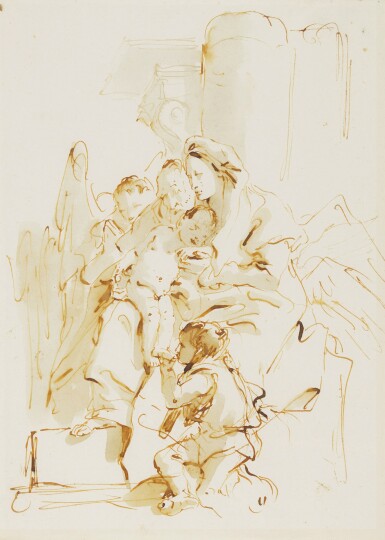
Property from the Collection formed by the Duc de Talleyrand
Giovanni Battista Tiepolo
The Holy Family with Saint John the Baptist, kneeling and kissing the Christ's Child foot
Auction Closed
January 26, 04:31 PM GMT
Estimate
80,000 - 120,000 USD
Lot Details
Description
Property from the Collection formed by the Duc de Talleyrand
Giovanni Battista Tiepolo
Venice 1696 - 1770 Madrid
The Holy Family with Saint John the Baptist, kneeling and kissing the Christ's Child foot
Pen and brown ink and gray wash
270 by 193 mm; 10⅝ by 7⅝in.
Count Leopoldo Cicognara;
Antonio Canova,
by inheritance to his half-brother, Monsignor Giovanni Battista Sartori-Canova;
Francesco Pesaro,
by whom sold to Col. Edward Cheney, Badger Hall, Shropshire,
by inheritance to his brother-in-law, Col. Alfred Capel-Cure, Blake Hall, Essex;
sale, London, Sotheby’s, 29 April 1885, probably part of lot 1024, to E. Parsons and Sons, London;
Probably with The Savile Gallery, London, Drawings by Giovanni Battista Tiepolo, exhib. cat., 1928;
Marie-Pierre-Louis Hélie de Talleyrand-Périgord, Duc de Talleyrand (1859-1937), Saint-Brice-sous-Forêt;
from whose heirs acquired by the British Rail Pension Fund;
with Hazlitt, Gooden and Fox Ltd, London,
from whom acquired in 1991 by Patrick and Mavis Walker, London
The present drawing depicting The Virgin and Child, with St Joseph, an Angel and a Young Saint John the Baptist, executed in Giovanni Battista Tiepolo’s signature vibrant and translucent golden brown ink with gray wash, is an exceptional example of one of the artist’s drawings for his celebrated series illustrating variations on the theme of the Holy Family, drawings which rank among the high points of the Tiepolo's draughtsmanship.
Dated by Knox to circa 1754-62, the drawings in this series are among the artist’s most accomplished and beautiful studies in pen and ink and wash. The much-admired group is not connected to any known painted scheme and nor does any individual sheet appear to relate to any surviving painting; they seem to have been drawn entirely for their own sake.
The celebrated series of some 76 drawings seems to have been contained in an album supposedly given by the artist to the Library of the Somasco Convent in Venice (see Provenance). This early provenance came to light when an album of drawings, which included mainly variations of the Holy Family subject, were exhibited and sold at the Savile Gallery, London, in May 1928. The Savile catalogue reproduced an inscription written by Edward Cheney on the inside of the front cover which provided the early provenance of the album.1 It is most likely that this drawing was part of the Savile group, but it is not obvious which lot number was given to the present drawing in the 1928 catalogue. It is not reproduced, but not all the drawings were illustrated and some are simply described as The Holy Family, making their firm identification impossible.
This drawing was subsequently bought by the Duc de Talleyrand. Antonio Morassi, in his catalogue of the Talleyrand Collection (see Literature) writes that this renowned collection was formed slowly and without a real program, the collector guided simply by his own sensibility and highly refined taste.2 The Duc de Talleyrand owned, among his Venetian drawings, no fewer than 31 sheets by Giovanni Battista, all of the highest quality. It seems he may have inherited his passion for Venetian art from his uncle, the Marquis de Biron.
Giovanni Battista cleverly maximizes the impact of the white surface of the paper, his natural light source, perfectly combining it with his application of pen and wash to achieve sparkling results. He has produced not only the most extraordinarily imaginative compositional variations, but has also adapted the traditional iconography of the Holy Family, incorporating a variety of additional elements through the course of the series, which results in each drawing being a truly different interpretation of the subject, and the series being a real virtuoso tour-de-force. In the present variation, the inclusion of St. John the Baptist and the decision to draw the Saint kissing the Christ Child's foot lends an imitate and tender tone to the overall grouping, an affectionate and respectful gesture that does not recur in many of the other drawings in this series.
‘They float on the page like exquisite arabesques, a marvelous monument to Giambattista’s talent and virtuosity.’3 In these appropriately poetic terms, George Knox characterised perfectly Tiepolo's astonishing series of drawings on the theme of the Holy Family, of which this is a splendid example.
1. G. Knox, Catalogue of the Tiepolo Drawings in the Victoria and Albert Museum, London 1960, p. 6
2. A. Morassi, op. cit., pp. 9-10
3. Tiepolo. A Bicentenary Exhibition 1770-1970. Drawings, mainly from American collections by Giambattista Tiepolo and the members of his circle, exhib. cat., Harvard University, Fogg Art Museum, 1970, under no. 89
You May Also Like










